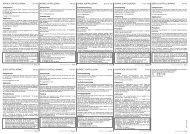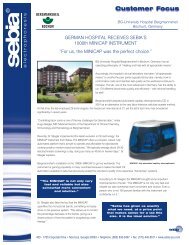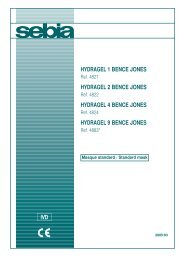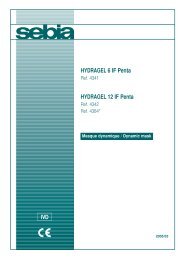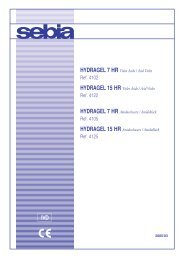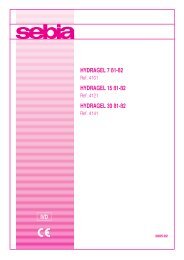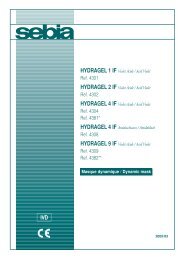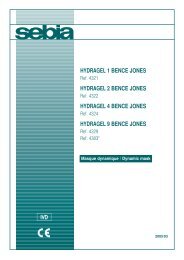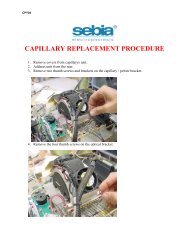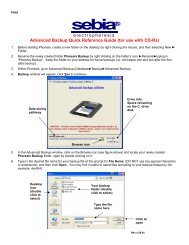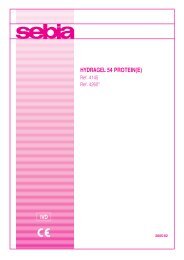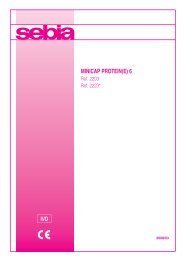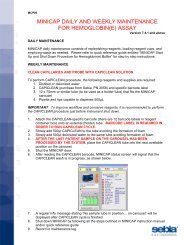ACID HEMOGLOBIN(E) K20 QUICK REFERENCE GUIDE
acid hemoglobin(e) k20 quick reference guide - Sebia Electrophoresis
acid hemoglobin(e) k20 quick reference guide - Sebia Electrophoresis
Create successful ePaper yourself
Turn your PDF publications into a flip-book with our unique Google optimized e-Paper software.
<strong>K20</strong>03<br />
<strong>ACID</strong> <strong>HEMOGLOBIN</strong>(E) <strong>K20</strong> <strong>QUICK</strong> <strong>REFERENCE</strong> <strong>GUIDE</strong><br />
Reagent Preparation<br />
• Citrate Buffer- Each vial of stock buffer solution to be diluted up to 1L with DI H2O (stable<br />
for 1 year).<br />
• Amido Black Stain- Each vial of stock acid violet stain to be diluted to 300ml with DI H20<br />
(stable for 1 year).<br />
• Destain Solution- Dilute destain solution -1ml stock to 1L with DI H20 (Stable for 1 week).<br />
• Hemolyzing Solution- Ready to use. ( Stable until expiration date on vial).<br />
Sample preparation<br />
• Use fresh anticoagulated blood for analysis.<br />
• Centrifuge anticoagulated sample at 5,000 rpm for 5 minutes.<br />
• Wash the red blood cells 2 times with 10 volumes of saline.<br />
• Hemolyze 10µL of packed red cells with 130uL of Hemolysis reagent.<br />
• Vortex for 10 seconds and incubate 5 minutes at room temperature<br />
• Dilute the hemolyzate 4 times with saline (example 25ul hemolyzate +75 ul saline).<br />
Procedure<br />
1. Apply 10µL of hemolyzed sample into the applicator wells.<br />
2. Place applicator(s) in wet storage chamber (teeth up) for ≥ 5 min. (max 8 hr. at 2 - 8 °C)<br />
3. Place the HYDRAGEL <strong>K20</strong> applicator carrier on a flat surface and raise the part of the<br />
applicator carrier with the numbered notches.<br />
4. Pipette 120µL DI water on the lower third of the frame printed on the HYDRAGEL <strong>K20</strong> carrier<br />
with the numbered notches.<br />
5. Blot gel quickly using thin blotter paper.<br />
6. Place the gel plate (the gel side up) with its edge against the stop at the bottom of the printed<br />
frame. Roll gel down. Avoid bubbles.<br />
7. Lower the applicator carrier with the numbered notches down to the intermediate position with<br />
the switch in high position, i.e. turn switch completely away from operator, until click is heard.<br />
8. Place applicator comb into position 9 of the carrier.<br />
9. Lower the carrier so that the applicator contacts the gel surface. DO NOT PRESS DOWN ON<br />
CARRIER<br />
10. After 1 minute, turn the switch to rise up the applicator, remove the applicator and discard.<br />
11. Prepare buffer and electrophoresis chamber appropriately.<br />
12. Place gel on the chamber bridge with the gel side facing down; the gel should dip about 1cm<br />
into the buffer on each side.<br />
13. Plug the chamber into the power supply.<br />
Sebia recommends using the constant voltage mode. Utilize these migration conditions for<br />
optimum performance. Set all other parameters to maximum accepted values.<br />
Migration Conditions SEBIA <strong>K20</strong> Maximum Values<br />
Volume of buffer per compartment 150ml I = 200mA<br />
Total buffer volume 300ml P = 60 W<br />
Migration time 35 minutes VH = 9999<br />
Constant voltage<br />
40 V<br />
After migration, unplug the chamber and carefully remove the gel plate.
14. Hot air Fixation- Dry the gel completely in the incubator-dryer at 80 C. <br />
Fixation with fixative solution<br />
• Place gel into gel holder.<br />
• Fill one tank with 150ml of fixative solution. Note: fixative should be prepared at<br />
lease 15 minutes prior to testing, by combining (vol./vol.)60% ethanol,10% acetic<br />
acid and 30% DI water.<br />
• Immerse the gel in the fixative for 15 minutes.<br />
• Remove the gel and dry it with 80 C airflow. Note: Gel must be completely dry.<br />
><br />
15. Immerse dried and cooled gel vertically in staining solution for 5 minutes.<br />
16. Destain in three successive baths of destaining solution until the background is completely<br />
colorless and clear.<br />
17. Soak up excess liquid on the gel with a tissue paper and dry gel in 80 C air stream.<br />
See package insert for procedural details and further information.<br />
Rev 01.15.03



